
ICCROM_ICS11_History_en
.pdf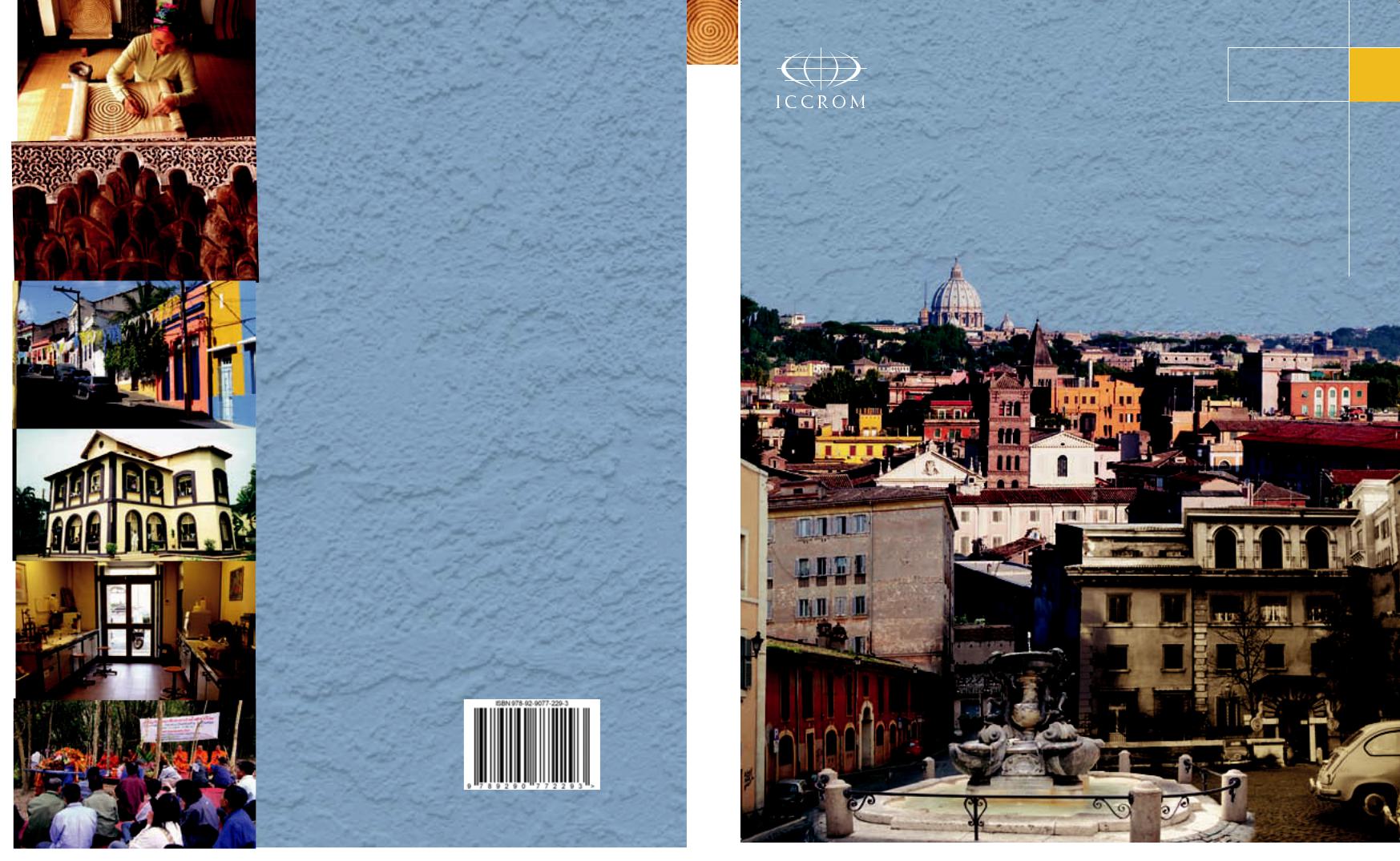
ICCROM 11
Conservation
Studies
ICCROM and the Conservation
of Cultural Heritage
A history of the Organization’s first 50 years, 1959-2009
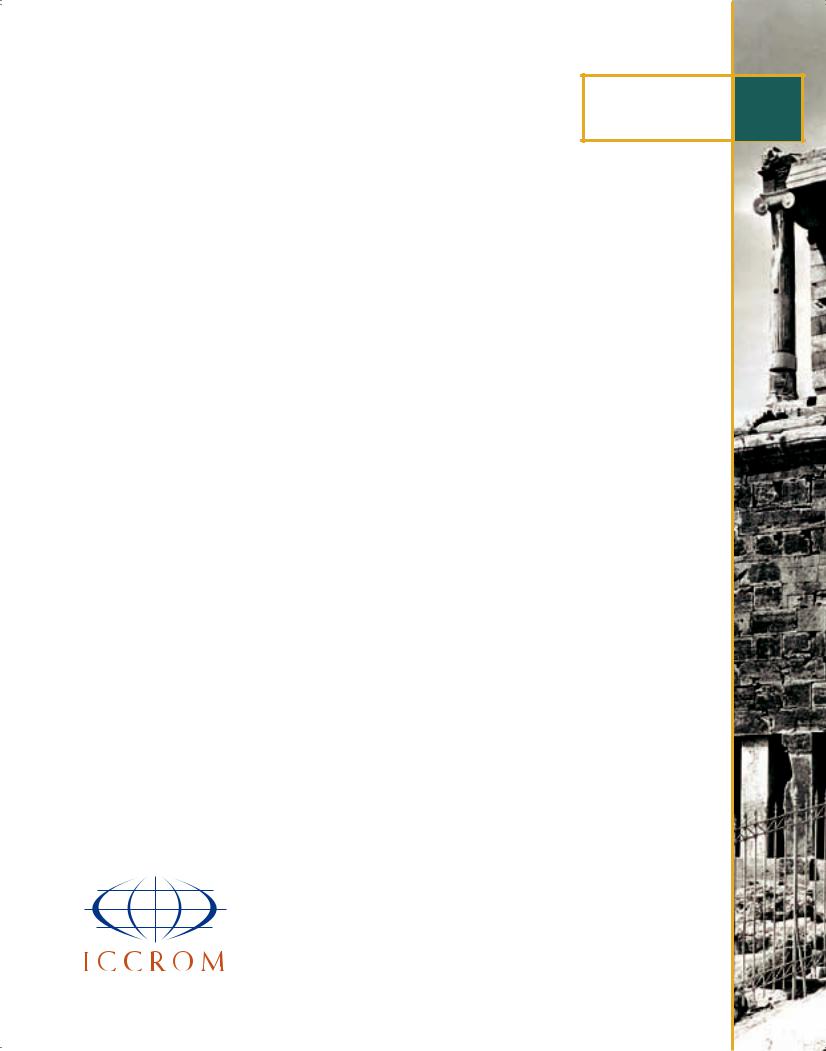
ICCROM 11
Conservation
Studies
ICCROM and the Conservation
of Cultural Heritage
A history of the Organization’s first 50 years, 1959-2009
Jukka Jokilehto

ICCROM and the Conservation of Cultural Heritage. A history of the Organization’s first 50 years, 1959-2009 by Jukka Jokilehto.
ICCROM Conservation Studies 11, ICCROM, Rome.
ISBN 978-92-9077-229-3
© 2011 ICCROM
International Centre for the Study of the Preservation and Restoration of Cultural Property via di San Michele, 13
00153 Rome, Italy
www.iccrom.org
Designed by Maxtudio, Rome
Printed thanks to the generosity of the State Administration of Cultural Heritage, People’s Republic of China and National Heritage Center of Tsinghua University, Beijing.
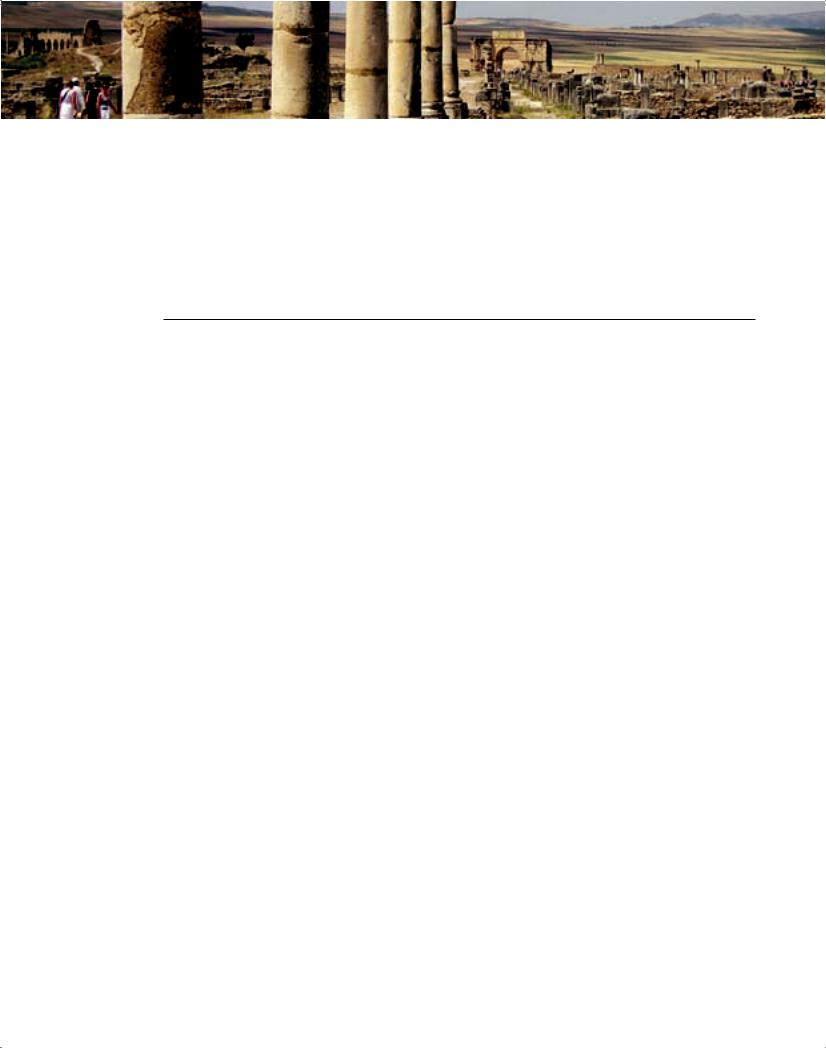
Contents
Foreword by the Director-General |
vii |
Foreword by the chairperson of ICCROM Council |
ix |
Acknowledgements |
xi |
List of illustrations |
xii |
Abbreviations used |
xviii |
|
|
The context for creation of an International |
|
1Conservation Centre |
1 |
||
|
|
The historical context |
2 |
|
|
Early international conservation initiatives |
3 |
|
|
The League of Nations |
3 |
|
|
International Museums Office (IMO) |
3 |
|
|
International Congress of Modern Architecture (CIAM) |
4 |
|
|
The institutional context after the Second World War |
5 |
|
|
UNESCO |
5 |
|
|
International Institute for Conservation of Historic and Artistic Works (IIC) |
6 |
|
|
International Council of Museums (ICOM) |
6 |
|
|
International Committee for Monuments at UNESCO |
7 |
|
|
International Union for the Conservation of Nature (IUCN) |
8 |
2 |
|
|
|
The foundation of ICCROM |
9 |
||
|
|
The context of UNESCO’s early work |
9 |
|
|
The two proposals by ICOM in 1948 |
10 |
|
|
Proposal by the Advisory Committee for Monuments (ACM) |
12 |
|
|
Establishment of the Rome Centre |
14 |
|
|
The period of the Provisional Council (1958-1960) |
16 |
|
|
Appointment of the Provisional Council |
16 |
|
|
Appointment of staff: the directorship of Harold Plenderleith |
17 |
|
|
Initial activities of the Rome Centre |
18 |
3 |
|
|
|
The Rome Centre (1960-1970) |
22 |
||
|
|
International context |
22 |
|
|
Administration of the Rome Centre |
23 |
|
|
Member States and the budget |
23 |
|
|
The first regular Council (1960) |
24 |
|
|
Personnel |
26 |
|
|
Premises |
26 |
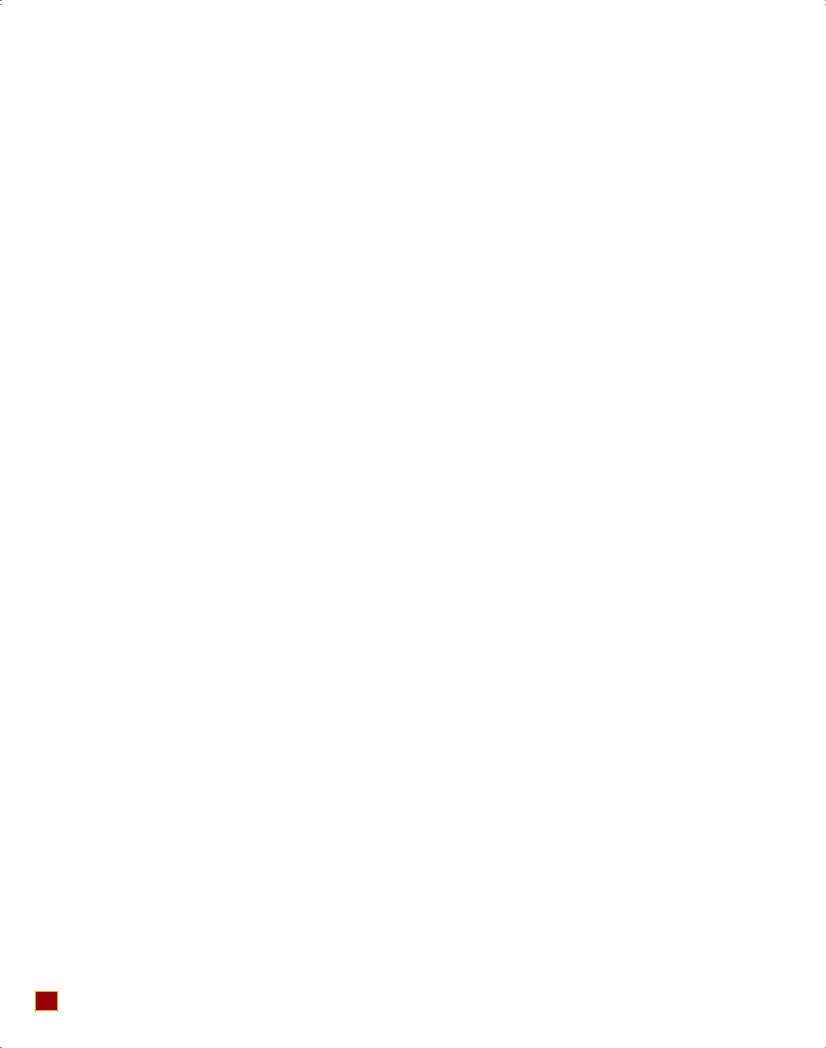
|
Planning of activities |
27 |
|
Proposed long-term programme (1966) |
28 |
|
Training of specialists in conservation |
29 |
|
Development of the Centre’s documentation |
29 |
|
Organization of specialist missions |
30 |
|
Policy for activities (1969) |
30 |
|
Principal initiatives in the 1960s |
31 |
|
Technical co-operation |
31 |
|
Nubian monuments |
32 |
|
Floods in Venice and Florence (4 November 1966) |
32 |
|
Documentation |
34 |
|
Publications |
34 |
|
The Library |
35 |
|
Conferences |
36 |
|
The Venice Meeting in 1964 |
36 |
|
Training |
36 |
|
Scholarships and visitors |
36 |
|
Regular training courses in Rome |
37 |
|
Research |
39 |
|
Reflection on the period 1960-1970 |
40 |
4 |
|
|
International Centre for Conservation (1971-1977) |
42 |
|
|
International context |
42 |
|
International Centre for Conservation (1971-1977): |
|
|
the directorship of Paul Philippot |
43 |
|
Administration |
43 |
|
Personnel |
43 |
|
Member States and the Council |
44 |
|
Premises |
45 |
|
Development of policies |
46 |
|
Policies of the Centre, December 1971 |
46 |
|
Scheme for future developments (1975-1985/90) |
47 |
|
Activities |
48 |
|
Library and documentation |
48 |
|
Research |
49 |
|
Science and techniques of conservation |
49 |
|
Conservation theory |
50 |
|
Publications |
52 |
|
Training: regular annual courses in Rome |
53 |
|
Architectural conservation |
54 |
|
Mural paintings |
56 |
|
Fundamental principles of conservation |
56 |
|
Security, climate control and lighting in museums |
59 |
|
Stone conservation in Venice |
59 |
|
Training typology |
59 |
iv
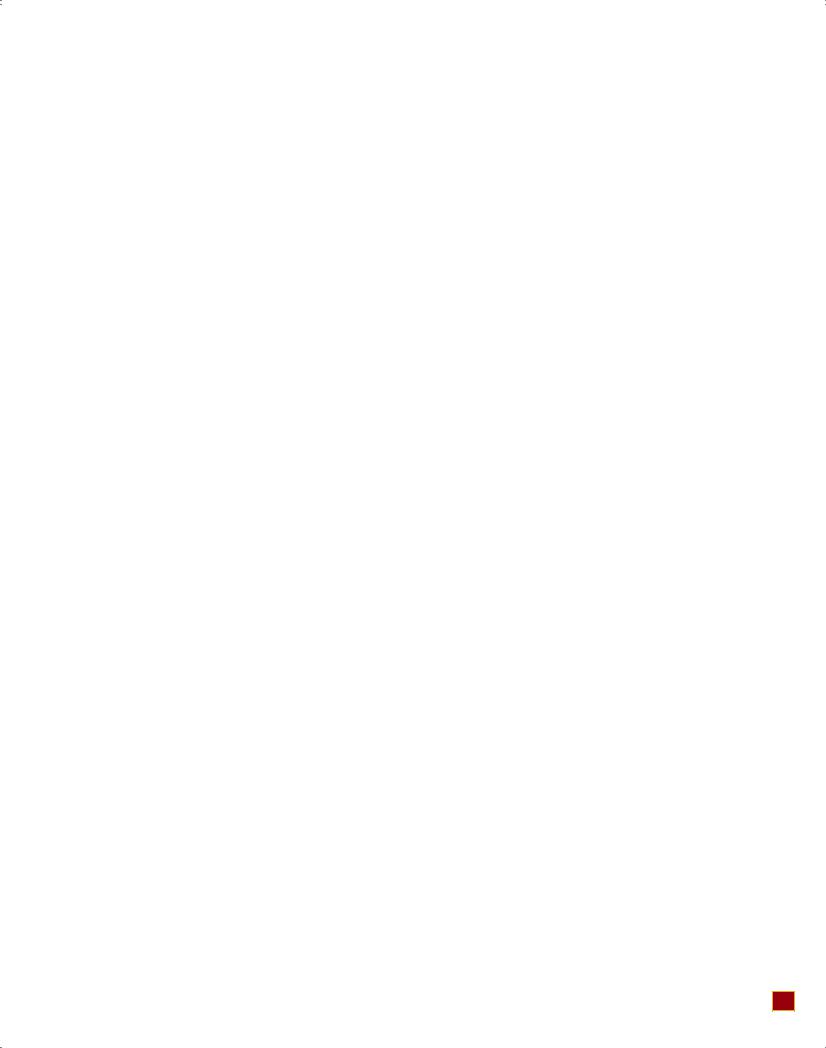
Regional activities and technical co-operation |
60 |
Technical assistance |
61 |
Reflection on the period 1971-1977 |
62 |
5 |
|
|
ICCROM comes of age (1977-1988) |
63 |
|
|
International context |
63 |
|
The name ‘ICCROM’: the directorship of Bernard Feilden (1977-1981) |
63 |
|
The new name and administrative reform |
64 |
|
Resources |
66 |
|
ICCROM Award |
67 |
|
Theory in practice |
67 |
|
Documentation |
69 |
|
Training and Research |
69 |
|
International collaboration |
75 |
|
Reflection on the period 1977-1981 |
78 |
|
A network of people (1981-1988): the directorship of Cevat Erder |
79 |
|
Administration and policies |
80 |
|
Training and documentation |
82 |
|
International and regional collaboration |
87 |
|
PREMA Programme for Sub-Saharan Africa |
88 |
|
Other training outside ICCROM |
88 |
|
Wood conservation course |
90 |
|
Reflection on the period 1981-1987 |
90 |
6 |
|
|
New global challenges (1988-2005) |
91 |
|
|
Period of conflicts and catastrophes |
91 |
|
Quo vadis ICCROM? (1988-1992): the directorship of Andrzej Tomaszewski |
92 |
|
Reviewing ICCROM policies |
93 |
|
Budget, premises and Statutes |
95 |
|
Associate Membership |
96 |
|
Administration and computerization |
97 |
|
Development of programme activities |
97 |
|
Reflection on the period |
100 |
|
“The crossroads of people, ideas and actions at the service of |
|
|
cultural heritage conservation worldwide” (1992-2000): |
|
|
the directorship of Marc Laenen |
100 |
|
Administration |
101 |
|
Member States |
101 |
|
Finances |
101 |
|
Premises |
102 |
|
Data management |
102 |
|
“What is ICCROM today?”: a management review |
103 |
|
Programme strategies |
104 |
|
International collaboration |
107 |
v

Working towards regional initiatives |
109 |
PREMA |
110 |
PREMO |
111 |
ARC and ITUC |
111 |
NAMEC |
112 |
GAIA and TERRA |
112 |
Science and technology |
113 |
Reflection on the period 1988-2000 |
116 |
Refining the quality (2000-2005): the directorship of Nicholas Stanley-Price |
116 |
Challenges of the period |
117 |
Administration and strategic developments |
120 |
Long-term financial strategy |
120 |
In-house or regional activities? |
121 |
Specific policies |
123 |
ICCROM’s Strategic Directions |
125 |
ICCROM Forum |
127 |
Collections and museums |
128 |
Evaluation of course programmes |
130 |
Technical services |
135 |
Reflection on the period 2000-2005 |
136 |
7 |
|
|
Working towards the future |
137 |
|
|
International context |
137 |
|
Verification of strategies and programmes: the directorship of Mounir Bouchenaki |
138 |
|
Programme development |
142 |
|
A word to conclude |
148 |
|
Notes |
150 |
|
Annexes |
159 |
|
Annex 1 |
|
|
ICCROM Member States |
159 |
|
Annex 2 |
|
|
ICCROM Council Members (1960-2010) |
161 |
|
Annex 3 |
|
|
The Founding Statutes of 1956 |
163 |
|
Annex 4 |
|
|
“The Rome Centre” - Ten Years After, by H. Daifuku (1969) |
166 |
|
Annex 5 |
|
|
List of books published by ICCROM |
170 |
vi
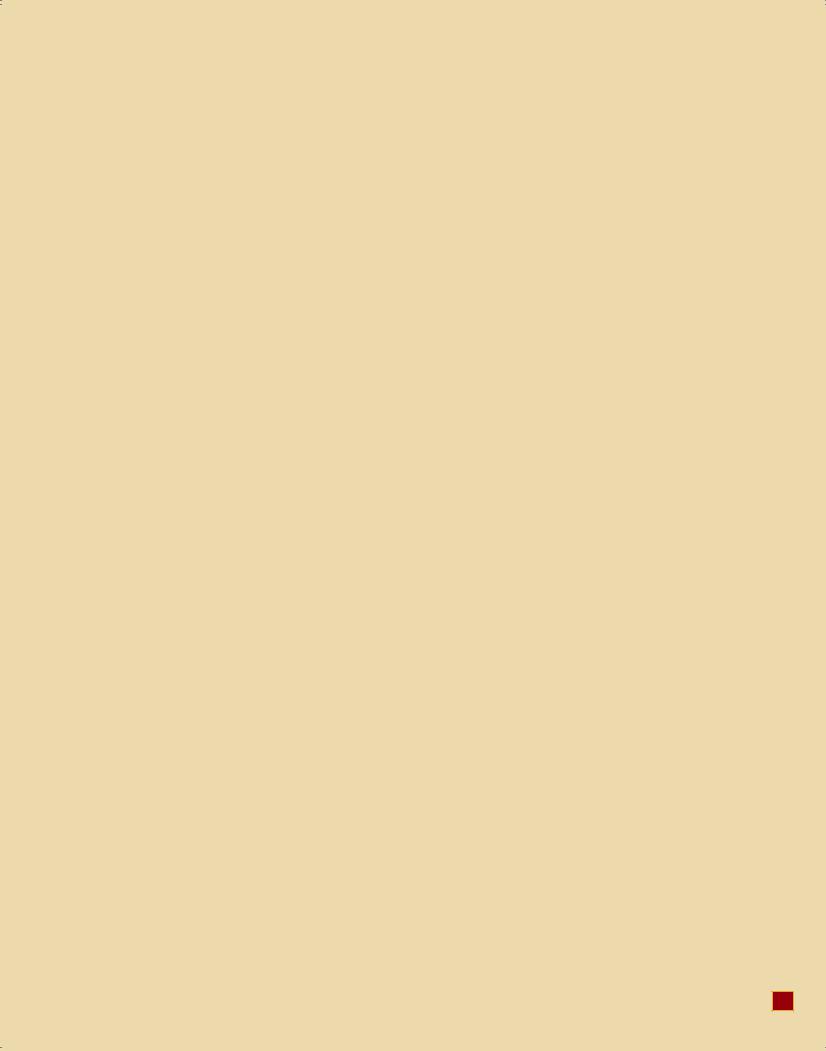
Foreword by the Director-General
I arrived at ICCROM in March 2006, at a moment in which I felt it was appropriate to begin celebrating its 50th anniversary. For it was in 1956 that UNESCO held its General Conference in New Delhi, India, where it was decided to establish an intergovernmental organization, the International Centre for the Study of the Preservation and Restoration of Cultural Property. Fifty years later, with the support of the ICCROM Council, we decided to turn this commemoration into a four-year celebration of milestones, ending in 2009 with the 50th anniversary of the ‘Rome Centre’ (as ICCROM was then called) becoming operational.
My predecessors, the late Andrzej Tomaszewski, Marc Laenen and Nicholas Stanley-Price had begun the process of documenting the history of ICCROM, an activity that Jukka Jokilehto and other colleagues were actively involved with through the years. Following their lead, in 2008, I encouraged the endeavours of the ‘ICCROM History Working Group’ – composed of Rosalia Varoli Piazza, Valerie Magar, Jukka Jokilehto, Gaël de Guichen, Calogero Bellanca and myself – to continue making contacts with former staff, course participants and partners, to gather information and stories that could culminate in a publication, created in the same spirit as the volume produced for the 60th anniversary of UNESCO. The gathering of this information, together with Jukka’s own research and memory, and the interviews that he conducted with several important figures in ICCROM’s development, have given this publication the richness that will mark it as an important contribution to the history of conservation and restoration of cultural heritage.
There have been several important aspects to the development of ICCROM and its global significance in the field: the advent of the concept of architectural heritage; the creation of a link between science and conservation through, for instance, the establishment of the laboratory; the pioneering of preventive conservation for museums and archives; and the creation of a vast international network of professionals and institutions practicing, studying, and teaching conservation and restoration. Over the past five decades, the ICCROM family has expanded to include teachers and experts – many of them ICCROM course alumni – who are leaders in their professions. They collaborate regularly on our projects and courses, and contribute to the ever-growing fabric of knowledge and experience in the conservation of both immovable and movable heritage. ICCROM can also be proud of being the force behind the creation of cultural heritage centres in developing countries, such as the Ecole du Patrimoine Africain (EPA) in Benin and the Centre for Heritage Development in Africa (CHDA) in Kenya.
This history of ICCROM puts into context some of the important doctrinal advances in the theory of conservation, such as the Venice Charter of 1964, the principles of Cesare Brandi, and the Nara Document on Authenticity (1994). Since 1972 ICCROM has been an Advisory Body to the World Heritage Convention, a contribution widely acknowledged as having shaped conservation practice worldwide and across professional fields. It has actively participated in groundbreaking discussions on philosophies and methodologies of the protection of cultural heritage, alongside other organizations such as UNESCO, ICOM, and ICOMOS. Jukka successfully demonstrates how ICCROM did not work within a restricted community, but brought new ideas and training schemes to the international platform, enhancing its role as a centre of excellence for training and capacity building, the achievements of which are visible all over the world. This is therefore not just an administrative history, but also an insight into ICCROM’s role at the forefront of a global movement.
foreword vii

This publication is the latest book in a series of relevant cultural heritage publications produced by ICCROM, which includes a wide range of topics from the conservation of textiles to armed conflict recovery and a series of essays dedicated to the career of Jukka: Conserving the Authentic: Essays in Honour of Jukka Jokilehto. It is also the latest of a number of publications on the history of ICCROM, which began in 1969 with a book entitled The First Decade 1959-1969. For the 20th anniversary another publication was produced under the directorship of Bernard Feilden, ICCROM Comes of Age 1959-1979. To celebrate 40 years of safeguarding cultural heritage, ICCROM in collaboration with the Italian Ministry of Foreign Affairs and Ministry of Cultural Heritage and Activities published a book in 2000 in two bilingual editions: English/Italian and French/ Italian. More recently, UNESCO’s Museum International dedicated its September 2009 issue to ICCROM, ‘Celebrating Excellence’, and ICCROM also produced a special edition of its annual Newsletter in English, French, Spanish, and Arabic commemorating 50 years of activities and achievements.
Through his hard work and dedication, Jukka has helped us to continue with these efforts, and for this we are incredibly grateful. We also extend our thanks to those who provided input to the manuscript, including Council Members, former staff, former Directors-General, members of the ICCROM Scientific Committee, and the anonymous peer reviewers. We also owe particular thanks to Nicholas Stanley-Price, who undertook the editing of this publication, and to Council Member Professor Zhou Lu from Tsinghua University, Beijing, for his generous offer to print this volume in his native China and offer it to the international community.
Mounir Bouchenaki
Director-General
viii ICCROM and the Conservation of Cultural Heritage. A history of the Organization’s first 50 years, 1959-2009

Foreword by the chairperson of ICCROM Council
50 years provides a good moment to take stock of ICCROM
This publication provides a full account of the organization, its work and achievements and its broader international context. The historical background and the early conservation initiatives are clearly set out before examination of the actual foundation of ICCROM and the establishment of the Rome Centre. The full history of ICCROM is then documented.
This is a substantial volume representing considerable archival research. There is extraordinary detail and the publication makes fascinating reading. Its author, Jukka Jokilehto, must be commended for his attention to detail and making the material so accessible under the many headings. The division into distinct periods is complemented by a reflection at the end of each. The annexes and footnotes at the back provide additional background material. It will become an essential reference for all those involved in the preservation of cultural heritage worldwide.
It is a reference work not just for ICCROM but for the international field of conservation, documenting the evolution of the organization and its context and its response over time to the needs of its Member States. This is an ongoing story which now continues into the next 50 years. The strategic directions have been recently reviewed along with the adoption of a set of formal policies and we look forward to moving to new premises during the next biennium. We look to the future based on a wellfounded past.
Though the project to write the history of ICCROM began some years ago, I would like to thank the current Director-General, Mounir Bouchenaki, for shepherding it to publication. I would also like to thank my colleague on Council, Prof. Lu Zhou, for arranging the printing of this publication in China and the Chinese authorities for generously underwriting the cost. Finally, on behalf of Council, I would like to thank Jukka Jokilehto for his substantial voluntary labours and his commitment to the project. He has produced a worthy document which stands as a testament to the remarkable work of ICCROM and its dedicated staff over the last 50 years.
Grellan D. Rourke
Chairperson, ICCROM Council
foreword ix
